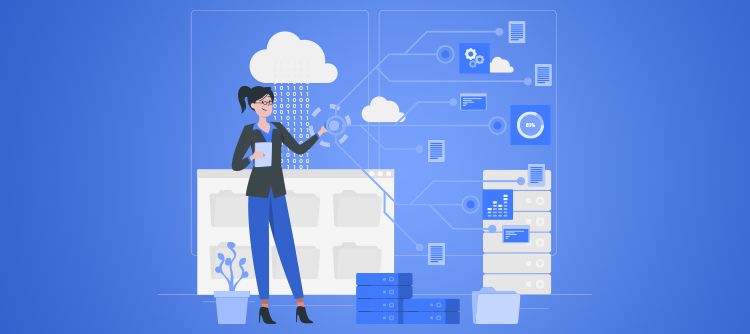
Subscribe to our Blog
We're committed to your privacy. SayOne uses the information you provide to us to contact you about our relevant content, products, and services. check out our privacy policy.

Jomin Johnson October 21, 20228 min read

Generating table of contents...
Developers today are using Docker to build microservices, which help to decentralize packages. They also serve to divide tasks into separate and stand-alone integrations that collaborate whenever required. As an example, developers for a nationwide food chain enterprise might build microservice applications for taking orders, processing payments, and creating a ‘produce food’ ticket for the makers and a delivery ticket for the delivery personnel. These microservices would then operate in a manner to get pizzas cooked and delivered all over the country from wherever orders come in.
Designing with microservices using Docker requires a new thought approach. However, it also creates limitless capabilities for building stable as well as scalable integrations. Let us see how they can work for you.
Developing an application using the microservices model is all about breaking down a “monolithic” application, and forming an architecture structure in which specialized, cloud-hosted smaller applications, each designed to perform a single task well, work together. Microservices serve to distribute application load and, therefore, ensure stability with services that are replicable, scalable and able to interact with one another when required.
Nevertheless, the major question is about the approach that needs to be picked up for breaking down the monolithic application. When decomposing the application into modules, software architects follow planned decomposition patterns and sort the new software modules into smaller but logical working groups.
Read our Blog “How to hire microservices developers from other countries”.
As an example, the shipping and tracking software ( of a grocery chain) currently using one application for fruit can be decomposed into smaller modules that process individual fruits such as one for bananas, another one for oranges, etc. While this may improve some aspects of tracking, decomposing the software package along logical subdomains—fruit types as in this case—can have major consequences on business ability.
The software developer expert Martin Fowler opines thus about the trap of hyper-focus during decomposition by subdomain. He says that when trying to split a large application into smaller parts, the management often tends to focus on the technology, UI teams, and the database and server-side logic teams. When separated along this type of logic, making simple changes entails more time required for cross-teams seeking budgetary approvals.
However, microservices architecture takes a different approach when reorganizing the modules. It decomposes applications around business functions, using cross-functional teams to develop, maintain, and continuously deploy microservices. Fowler emphasizes a business-focused decomposition.
Read our blog: Microservices Architecture - When and How to Shift
Microservices are typically designed to decentralize traditional data storage models found in monolithic applications. Microservices work best with their own data stores which are either repeated instances of the same database technology or a mix of separate database types that best suit the specific service. This approach is referred to as Polyglot Persistence. This ability to mix and match data-store types presents the developers with myriad possibilities.
The power and possibilities of microservices also throw up challenges that the developers have to address and manage regularly.
Services that are distributed across different hosts are difficult to track. Collaborating with microservices is a tougher job as they are scattered throughout your environment. They have to be inventoried and made quickly accessible.
A microservice consumes fewer resources than monolithic applications; however, it is important to keep in mind that the number of microservices in production can grow rapidly when your architecture scales. If they are not properly managed, several little hosts can together consume more resources than a monolithic application.
In the event that you are utilizing the AWS environment, there is a bottom limit to the resources you can assign to a task. Microservices can be very small and may require only a portion of a minimal EC2 instance. This can result in wasted resources and excess costs that far exceed the actual requirement (of resources) of the microservice.
Microservices can be developed in different programming languages. However, every language is dependent on its own libraries and frameworks. Therefore, these multiple programming languages while in play will require completely different sets of libraries and frameworks. This tends to grow resource overheads and makes deployment a complex consideration.
Download our eBook, "Choose the best microservices vendor and trim the costs."
Nevertheless, these challenges can be tackled with the use of container technology such as Docker which helps to fill in the gaps.
Docker is a set of PaaS products that use virtualization at the OS level to deliver software in containerized packages. Docker engine is the software that hosts the containers.
The Docker technology of the container is now being emulated by other container services and it helps to address some of the biggest challenges when building microservices architecture.
Do you want to deploy, manage, and scale up your mobile/on-premise/cloud microservices applications? Call us today!
Task Isolation
One can create a Docker container for each microservice. This resolves the resource bloat problem that occurs because of over-provisioned instances that lie idle under the minimum strain of a lone service. Also, multiple containers can be run per instance.
Support Multiple Coding Languages
Separating all the services required to run a language, along with the libraries and framework information, into linked containers will help to simplify and manage multiple platforms.
Database Separation
It is a good idea to use containers to host one or more data volumes. These can be then referenced from other microservices/containers. The concept can be explained thus:
Read our blog : Microservices architecture and distributed tracing
This method of access provides the benefit that it abstracts the original data location, thus making the data container a logical mount point. The application containers that access the data container volumes are created and destroyed while maintaining the data in a dedicated container.
Automate Monitoring
The data flow can be monitored deeply to derive important insights from the container logs using relevant tools. This would help to save your team’s time and accelerate the CD pipeline.
Designing efficient microservices architecture requires planning, effort, and time. Some basic points, if kept in mind, can help you to stay in control of the complex environment that is created by microservices in action.
Conclusion
Though microservices may be a relatively new approach for making software systems that will be easy to scale, their long-term effects are commendable as established by many large corporations. However, the capabilities that they bring to your large applications in a DevOps environment cannot be denied.
We believe in long-term win-win relationships with our strategic partners. If you want to migrate to microservices, call us today!
At SayOne, we offer independent and stable services that have separate development aspects as well as maintenance advantages. We build microservices especially suited for individuals' businesses in different industry verticals. In the longer term, this would allow your organization/business to enjoy a sizeable increase in both growth and efficiency. We create microservices as APIs with security and the application built in. We provide SDKs that allow for the automatic creation of microservices.
Our comprehensive services in microservices development for start-ups, SMBs, and enterprises start with extensive microservices feasibility analysis to provide our clients with the best services. We use powerful frameworks for our custom-built microservices for different organizations. Our APIs are designed to enable fast iteration, easy deployment, and significantly less time to market. In short, our microservices are dexterous and resilient and deliver the security and reliability required for the different functions.

We're committed to your privacy. SayOne uses the information you provide to us to contact you about our relevant content, products, and services. check out our privacy policy.

About Author
Head of AI-Retail @ SayOne Technologies|Project Manager | Product Owner - CSPO®| Lead Business Analyst

We collaborate with visionary leaders on projects that focus on quality